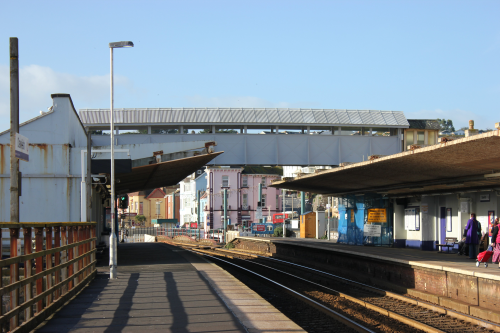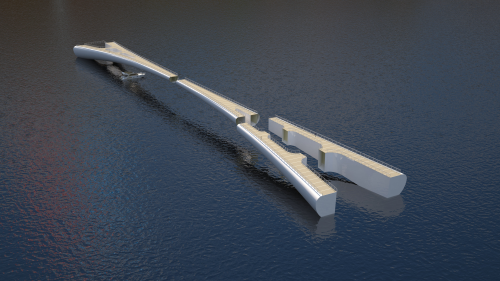

Part 1 of this feature focused on the use of composites in rail vehicles. In Part 2 we look at the use of composites in rail infrastructure such as bridges.
Infrastructure
Many of the composite components currently being developed for use in the rail industry are unlikely to be noticed by most passengers. However in railway infrastructure the benefits are clearly noticeable, because of the absence of rust and other signs of corrosion.
Parsons Brinckerhoff (PB) is an international consultancy which specialises in designing and improving all types of infrastructure including that used in railways. PB has been working with Network Rail in the UK to rehabilitate and develop sustainable rail infrastructure using FRP.
PB claims it designed the first two pedestrian bridges in the UK made from this lightweight, low maintenance, durable material. PB designed a footbridge that was installed over the River Leri in Wales in 2009. Made entirely from FRP, this footbridge runs adjacent to an existing railway bridge. According to PB, FRP was especially suitable because the structure is in a coastal tidal location where corrosion would otherwise be a problem.
“This project involved new research and advances in connection technology to achieve this large FRP structure,” says Jon Shave, Lead Bridge Designer.
“We were keen to use these materials in an alternative structural configuration and explore further the significant benefits that are possible.”
In 2007, PB designed the first FRP footbridge for Network Rail at St. Austell in Cornwall, UK. It replaced a corroded wrought iron and cast-iron structure.
PB’s work on the St. Austell and River Leri bridges was an outgrowth of a 2004 study for Network Rail in which PB highlighted a range of potential uses for FRP, including footbridges, stairs, platforms, and walkways. The study also identified a number of benefits derived from the use of FRP, among them minimal maintenance, ease of installation, and durability.
Work by Optima Projects and presented by David Kendall, Managing Director of this consultancy, in Derby suggests FRP has a bright future in railway bridges. He says that it offers these advantages over traditional metal bridges:
- significantly reduced mass;
- superior durability – less maintenance, disruption and through-life cost;
- new aesthetic possibilities with complex moulded forms;
- offsite construction reducing time disruption on site;
- longer clear span – less impact on space below; and
- overall cost reduction, especially through-life.
The composite Bradkirk Bridge, featuring materials and technology supplied by Gurit UK demonstrates the potential of composite bridges. It was installed in six hours in 2009 in Blackpool, Lancashire, UK. The bridge replaced an existing metallic bridge which required extensive maintenance and needed to be raised for potential future electrification of the line.
The bridge was manufactured by AM Structures for Network Rail and engineered by WYG. It consists of two 12 m spans and two flights of steps. Each span features a fully moulded composite monocoque structure and was manufactured using Gurit’s SPRINT™ (epoxy) technology material. The bridge has two skins and a closed cell foam core. The skins were made from glass reinforced epoxy and produced using SPRINT, which is a thin film resin infusion process, and the core consists of Gurit’s Corecell™ SAN foam. The structure was laminated in a female mould and cured under vacuum at a temperature of 70°C.
Gurit’s Spabond 340LV and Ampreg 22 were also used for bonding, resulting in a virtually steel free construction with each span weighing only 1.6 tonnes. A steel span designed to the current regulations would be likely to weigh around 16 tonnes.
The Network Rail structure, with a total scheme cost of £665,000, was installed by Birse Rail during a routine line closure. The bridge is expected to last in excess of 60 years and be virtually maintenance free with the exception of routine inspections and replacement of non-slip finishes and stair noses.
Network Rail is also using a composite in a project further south. Recently work started on the new footbridge for Dawlish railway station in south Devon, UK, as part of a £1 million improvement project. The project was recently completed.
Network Rail’s route asset manager for buildings, Simon Gyde said:
“The renewal of Dawlish Station footbridge is driven by the asset condition and safety. The existing footbridge was last reconstructed in 1937, using steel girders taken from Park Royal Station. Despite numerous repair schemes being carried out, the bridge suffers from the harsh marine environment, and now has significant areas of corrosion to the main girders and roof structure with poor protective paintwork and rotten timber decking.”
The footbridge will be the second FRP footbridge to be installed on the Western Route. The first was at St. Austell in Cornwall, UK in October 2007.
Composite is being used because the steelwork of the existing footbridge has been badly corroded by the harsh marine weather conditions. The timber decking had rotted and the protective paintwork had broken down.
The plastic components were supplied by Pipex px®, the Plymouth, Devon, UK-based structural composites manufacturer, replicating the style of the original steel bridge at the Grade II listed station. The Dawlish Station footbridge mainly utilises standard FRP pultruded profiles, combined with parapet sandwich panels moulded by film infusion. The stairs at each end of the bridge are also moulded FRP units.
Network Rail’s engineers considered a number of alternatives, including a complete refurbishment and strengthening scheme using traditional materials, before deciding on composites. Not only will the manufactured mouldings replicate the existing style of the original steel bridge (even down to plastic rivet heads), but it will be better able to withstand the harsh marine environment along the Dawlish seafront. The new structure is expected to be lighter and easier to install and will require considerably less maintenance than the footbridge it replaces. (See
Those projects suggest that composites have a bright future in the rail industry. Increasing demands to reduce time needed for engineering works are likely to stimulate demand for more innovative composite solutions. ♦
This article was also published in the November/December 2012 issue of Reinforced Plastics magazine.
The digital edition of Reinforced Plastics is distributed free of charge to readers who meet our qualifying criteria. You can apply to receive your free copy by completing the registration form.
Also see:
- Can trains be half plastic? Part 1 and Part 2. Today’s rail vehicles use composites widely in their interiors, but exteriors are still mainly metal. The latest aircraft, however, are 50% composite – including their load-bearing primary structures. This article asks why this is, and looks at the use of composites in rail interiors and exteriors.






